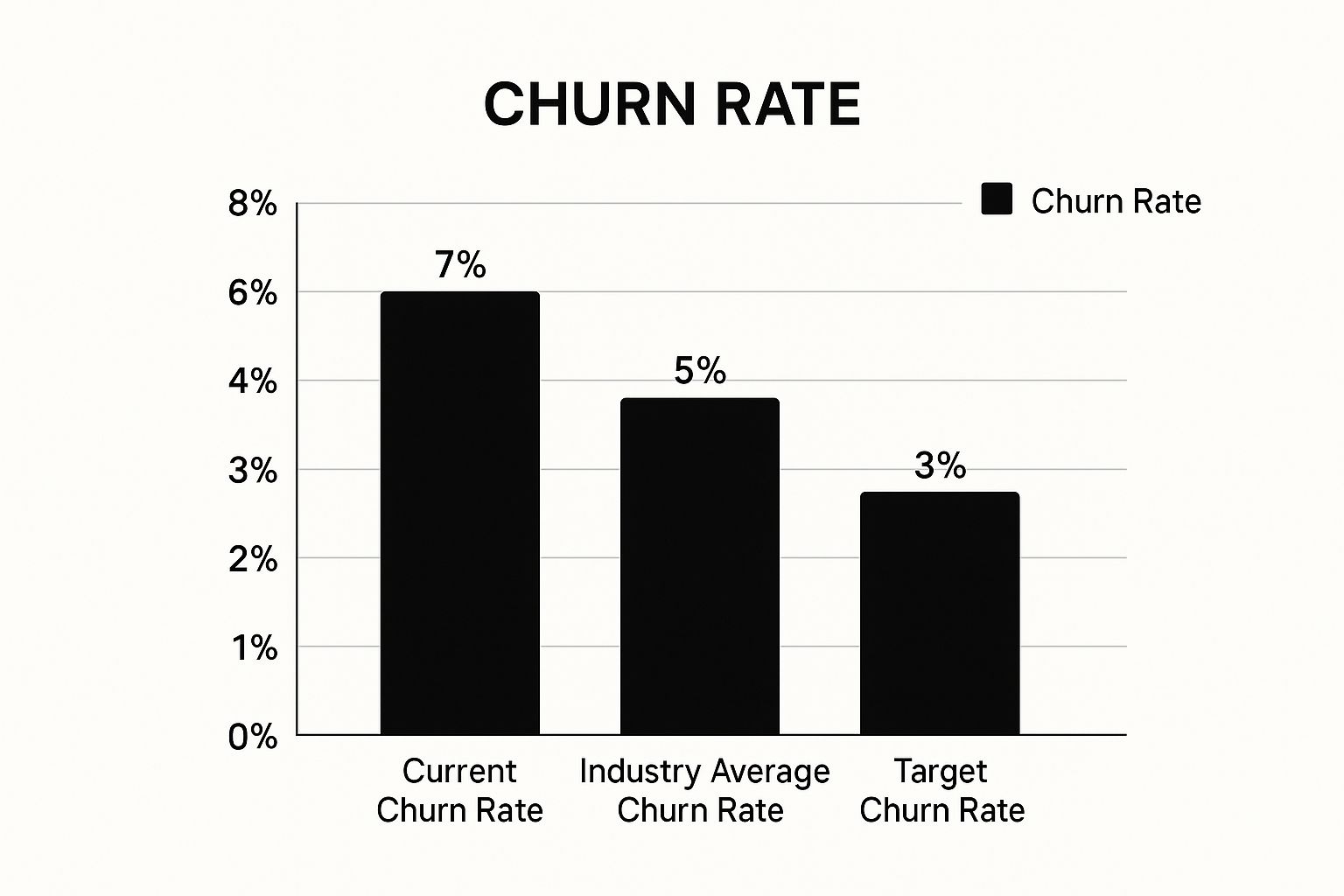Before you can even think about fixing your churn problem, you have to get your hands dirty with the data. Guesswork won't cut it. You need to figure out why customers are actually walking away, and that means looking at the right numbers and, more importantly, asking the right questions.
Understanding Why Customers Actually Leave
You can't patch a leak if you don't know where it is. Trying to reduce customer churn without first diagnosing the root cause is like throwing spaghetti at the wall to see what sticks. It's messy, wasteful, and rarely works. To make any real progress, you have to dig into the why behind your churn numbers.
First things first, let's get a handle on the two main types of churn. Just separating these two can give you a surprising amount of clarity.
- Voluntary Churn: This is the one we all worry about. A customer actively decides to cancel their subscription. Maybe the product wasn't a good fit, they had a terrible support experience, or a competitor wooed them away. This is all about their perception of your value.
- Involuntary Churn: This is the silent killer. A customer churns without meaning to, almost always because of a payment failure. An expired credit card or a declined transaction is often the culprit.
We tend to focus on voluntary churn, but ignoring involuntary churn is a massive unforced error. It’s often the low-hanging fruit, easily fixed with better dunning management tools and smart payment reminders.
Slice and Dice Your Churn Data for Real Insights
Your overall churn rate is just a headline. It tells you there's a problem, but it gives you zero clues about how to solve it. The real story is always in the details, and you find those details through segmentation.
Think about it. What if you discovered that customers who signed up through your Google Ads campaign have a 30% higher churn rate than those from organic search? That tells you there’s a serious disconnect between your ad copy and the actual user experience for that group. Or maybe you find that users on your mid-tier "Pro" plan are leaving faster than your "Basic" users. That’s a massive red flag signaling a potential value-for-money problem at that specific price point.
The most powerful insights are buried in the segments. Don't just stare at your aggregate churn rate. Break it down by customer persona, acquisition channel, subscription plan, and even signup cohort. This is how you transform a scary number into an actionable roadmap.
Take a look at this. It’s a simple but effective way to visualize where you stand.

Seeing the gap between your current churn, the industry benchmark, and your goal makes the problem tangible. It creates a sense of urgency and helps rally the team around a common objective.
Key Churn Metrics You Need to Track
To properly diagnose your churn problem, you need to track more than just the top-line number. These key metrics will give you a much clearer picture of what's happening under the hood and help you build a smarter retention strategy.
| Metric | What It Measures | Why It's Important |
|---|---|---|
| Customer Churn Rate | The percentage of customers who cancel their subscriptions in a given period. | The big-picture health indicator. It tells you if you have a retention problem. |
| Revenue Churn Rate | The percentage of monthly recurring revenue (MRR) lost from existing customers. | Measures the financial impact of churn. High-value customers churning hurt more than low-value ones. |
| Customer Lifetime Value (LTV) | The total revenue a business can expect from a single customer account. | Helps you understand the long-term value of retention. A higher LTV justifies more investment in keeping customers. |
| Net Revenue Retention (NRR) | The percentage of recurring revenue retained from existing customers (includes upgrades, downgrades, and churn). | The gold standard for SaaS health. An NRR over 100% means you're growing from your existing customer base alone. |
Looking at these metrics together provides a multi-dimensional view. You might have low customer churn but high revenue churn, which means you're losing your best customers—a critical insight you'd otherwise miss.
Create Feedback Loops That Actually Work
If you want to know why people are leaving, the best way is often the most direct: just ask them. But how and when you ask makes all the difference.
One of the most valuable tools in your arsenal is the exit survey. When a user clicks that "cancel subscription" button, that's your golden opportunity. Don't let them leave without presenting a simple, one-question survey asking why they're canceling. This is your last, best chance to get honest, unfiltered feedback.
Recent data shows that over half of all churn comes down to a few core problems. A clunky onboarding process is responsible for 23% of churn, a weak relationship with the company drives 16%, and poor customer service causes another 14%. This really drives home how vital the entire customer journey is, right from the very beginning. You can read more about what drives customer churn in this excellent analysis.
Ultimately, getting a firm grip on the "why" is the foundation of any successful churn reduction effort. By combining sharp data segmentation with direct customer feedback, you can stop just reacting to churn and start proactively preventing it.
Designing an Unforgettable Onboarding Experience
You only get one chance to make a first impression. In the world of SaaS, that first impression is your onboarding process. This isn't just about showing off your product's features; it's the critical make-or-break window where a new customer decides if your tool is truly the answer to their problems.
If that initial experience is confusing, generic, or overwhelming, you’ve basically handed them an exit sign. Users who can't see the value right away won't stick around to find it.
The real goal here is to get each user to their personal "aha!" moment as quickly and smoothly as possible. That's the instant they see exactly how your product solves their specific problem. A well-crafted onboarding experience makes this moment feel inevitable, turning a curious new signup into a confident, long-term advocate for your brand.

Tailor Onboarding to User Goals
Let's be honest: a one-size-fits-all onboarding flow doesn't work. A marketing manager using your tool has entirely different goals than a software developer, and your welcome sequence needs to recognize that from the jump. The simplest way to do this? Just ask them.
A simple survey on the welcome screen can work wonders. Based on their answers, you can roll out a personalized path that highlights only the features they’ll actually care about. This immediately cuts through the noise and avoids the user frustration that comes from being shown a bunch of tools they have no use for.
Think about a project management tool. It might ask new users:
- What's your main objective for using our platform?
- Are you here for team collaboration or personal task management?
- What kind of project are you kicking off?
Someone trying to manage a team's content schedule would then be steered toward setting up team members and creating a calendar view, completely sidestepping advanced features like budget tracking for now.
Guide Users with In-App Tutorials
Once you know what a user wants to accomplish, in-app tutorials become your best friend. But forget those long, click-through-everything product tours of the past. Modern onboarding uses contextual prompts, helpful tooltips, and progress-tracking checklists that pop up right when they're needed most.
These guides should be interactive. You want to encourage users to do something, not just watch. A well-placed checklist, for example, gives them a clear roadmap to getting set up and delivers a satisfying sense of accomplishment as they tick off each item.
We saw a project management tool slash its first-month churn by a whopping 40% by completely rethinking its welcome sequence. Instead of a show-and-tell of every single feature, they focused the entire onboarding experience on helping the user complete one critical task: setting up their very first project.
That single-minded focus delivered an immediate win and built the user's confidence from day one. You can dive deeper into creating these kinds of effective welcome flows in our guide to SaaS onboarding best practices.
Reinforce Value with Lifecycle Emails
Your job isn't done once the user is inside the app. A smart, well-timed lifecycle email campaign is essential for keeping them engaged and reminding them why they signed up in the first place.
These emails shouldn't be random. They should be triggered by what the user is—or isn't—doing in your product.
- Welcome Email: This should go out immediately to confirm their signup and set the right expectations.
- Milestone Emails: Did a user just accomplish something big? Celebrate it! An email saying, "Congrats on creating your first invoice!" goes a long way.
- Educational Nudges: If a user hasn't touched a key feature relevant to their goals after a few days, send a friendly email with a quick tip on how to get started with it.
Automating this is the only way to do it at scale. If you want to get really good at this, you can explore resources that teach you how to master automated client onboarding strategies. By blending personalized in-app guidance with intelligent, automated emails, you create a powerful, "sticky" experience that doesn't just cut churn—it builds the foundation for true customer loyalty.
Building Loyalty Through Proactive Engagement
https://www.youtube.com/embed/7t3lTYEd_PM
Let's be honest: reducing churn isn't about damage control. If you're waiting for a customer to become disengaged before you act, you've already lost half the battle. The most successful SaaS companies I've seen don't play defense; they play offense. They actively build relationships that become so essential to a customer's workflow that leaving feels like a real step backward.
This all starts with getting to know your users on a deeper level. You need to use your data not just to spot red flags, but to find opportunities to delight and engage. The first step is to figure out who's who in your user base.
Identify Your Power Users and Potential Advocates
Somewhere inside your user list, there's a group of people who just get your product. These are your power users. They're in your app all the time, they use the advanced features you spent months building, and your tool is a non-negotiable part of their day.
These folks are your single greatest asset in the fight against churn. They’re also your best source for referrals, glowing testimonials, and killer case studies. Keeping them happy doesn't just lock in their business—it turns them into a volunteer marketing team that brings in more people just like them.
Here’s how you can engage your champions:
- Give them exclusive previews: Let them test new features before anyone else and ask for their honest feedback. It makes them feel like valued insiders.
- Spotlight their success: Feature them on your blog, in a webinar, or as a detailed case study. They get free publicity, and you get powerful social proof.
- Set up a referral program: Give them a good reason to spread the word by rewarding them for bringing new customers into the fold.
Re-Engage Users Before They Drift Away
On the flip side, you have users who are starting to fade. You know the signs: logins are less frequent, they aren't using key features, and maybe a support ticket has gone unanswered. This is a critical moment. You have to intervene with a strategic nudge, not just another generic "we miss you" email that gets instantly deleted.
A well-timed, targeted message can pull them back in by showing them real value. Think about what they're missing. Did you just release a feature that solves a problem they mentioned during onboarding? Is there a common hurdle for users at their stage that you can help them navigate?
For example, a CRM I worked with noticed a group of users would have a great first month, but their activity would nosedive afterward. Instead of writing them off, they launched a webinar series focused specifically on advanced reporting features—a major value-add these users hadn't even touched.
The result was a 15% lift in feature adoption among that specific group and a noticeable drop in their churn rate. It wasn't a huge, company-wide campaign. It was a surgical strike aimed at a very specific problem.
Implement a Value-Driven Communication Plan
Every single piece of communication you send—every email, every in-app notification—should deliver value, not just add to the noise. It needs to have a purpose, and that purpose should be to help your customer win. This is a fundamental part of how you can successfully improve client retention for the long haul.
A solid communication plan might look something like this:
| Communication Type | Purpose | Example |
|---|---|---|
| Feature Updates | Show continuous improvement and highlight new value. | "Hey, remember you asked for X? We just launched it! Here’s how to use it." |
| Insightful Content | Provide industry insights that help them do their jobs better. | A monthly newsletter with an article on "5 Ways to Boost Productivity with [Your Tool]." |
| Success Check-ins | A personal touch from a customer success manager to offer help. | "Just checking in to see how you're getting on with your new project. Any questions I can help with?" |
This kind of proactive, personalized outreach shows you’re invested in their success, not just their subscription fee. It builds a genuine relationship. To get this done at scale, some companies are even exploring tactics like building an AI retention bot to combat customer churn to automate personalized check-ins.
When you proactively engage both your biggest fans and your at-risk users, you create an environment where customers feel seen, supported, and constantly reminded of the value you bring to the table. That’s how you build loyalty that actually lasts.
Use Customer Feedback to Steer Your Roadmap
Let's be honest—when a customer cancels, it stings. But buried within that painful notification is a gift: a free, brutally honest roadmap for your product. The reasons people leave, the features they claim are missing, and the frustrations they share aren't just complaints. They're direct instructions on how to build a stickier, more valuable product.
The trick is learning how to systematically collect, analyze, and act on this feedback. Too many companies treat it as a passive task, letting insights rot in a spreadsheet. To really move the needle on churn, you need to build an active, closed-loop system where customers see tangible proof that their voices are shaping your future.

Go Deeper Than Basic Surveys
High-level metrics like Net Promoter Score (NPS) or Customer Satisfaction (CSAT) are fine for a quick pulse check. But they rarely uncover the specific, granular details you need to make smart product decisions. To really understand what makes users tick—or what makes them leave—you have to cast a wider net.
Think of it as building a portfolio of insights from multiple sources:
- In-App Feedback Widgets: A simple "Got feedback?" button is incredibly powerful. It lets users share ideas or report frustrations the very moment they experience them, which gives your team invaluable context.
- Customer Interviews: Nothing beats a real conversation. Make a habit of talking to your newest users, your most dedicated power users, and especially those who have recently churned. A single 30-minute call can reveal more actionable insights than a thousand generic survey responses.
- Support Ticket Analysis: Your support team is on the front lines, hearing it all. Regularly mine your support tickets for recurring issues, common feature requests, and points of confusion that are silent churn drivers.
Create a Central Hub for Every Piece of Feedback
The real challenge isn't collecting feedback; it's making sense of it. When suggestions are scattered across Slack channels, email inboxes, and random spreadsheets, they're practically useless. You need a single source of truth.
This could be a dedicated tool like Canny or UserVoice, or even a well-organized database in Notion or Airtable. The key is to tag and categorize every single piece of feedback. For instance, when a customer asks for a new integration, it should be tagged with "feature request," "integration," and the name of the specific app they want to connect.
With a system like this, your product team can instantly answer critical questions. "What are the top three feature requests from our enterprise customers?" "What bug is causing the most support tickets this month?" This data-driven approach takes the guesswork out of building your roadmap.
Key Takeaway: Stop letting valuable feedback die in random channels. By centralizing and categorizing every customer suggestion and complaint, you transform anecdotal evidence into undeniable data that can steer your entire product strategy.
Close the Feedback Loop—Visibly
Collecting and analyzing feedback is only half the battle. The most crucial step, and the one most companies skip, is closing the loop. This means showing your customers that you're not just listening but actively building based on their input. When users see their ideas come to life, it builds incredible loyalty and makes them feel like part of your team.
A public "ideas board" or a visible product roadmap is a fantastic way to do this. I saw a B2B SaaS company implement this using a public Trello board, and the results were stunning. Users could submit feature ideas, upvote others, and track the status of each request—from "Under Consideration" to "In Progress" to "Launched."
This simple act of transparency completely changed the game for them.
- It validated customer feelings: Users felt heard and respected, even if their specific idea wasn't chosen.
- It gave the product team clear data: They no longer had to guess what to build next. The most upvoted features became the obvious priorities.
- It reduced feature-related churn: Customers who were thinking of leaving for a competitor with a specific feature were often willing to wait when they could see it was officially on the roadmap.
When you close the loop, you shift the entire customer relationship from a transaction to a partnership. Your customers become co-creators who are invested in your success, making them far less likely to churn. This is how you turn customer feedback from a simple metric into your most powerful tool for building a product people can't live without.
Winning Customers Back with Smart Offboarding
Even with a top-notch product and fantastic customer engagement, some churn is inevitable. When a user clicks that “cancel” button, it’s easy to feel defeated. But this isn't the end of the line. It's actually one last, critical chance to understand why they're leaving and maybe even change their mind.
Think of it less as an ending and more as a crucial feedback and retention touchpoint. A smart offboarding process isn’t about building a maze to trap people. Forcing a frustrated customer to stay just breeds resentment and negative reviews. The real goal is to turn the cancellation flow into an intelligent, empathetic conversation—one that can often lead to a save.
The Power of a Dynamic Cancellation Flow
The moment a user decides to cancel is your chance to ask one simple, vital question: "Why are you leaving?" This isn't just for your internal reports; their answer should immediately change what they see next. This is where a static "we're sorry to see you go" page misses the mark and an interactive flow truly shines.
Let’s walk through a few common scenarios and how you can respond in real-time:
- They say: "It's too expensive." Don't just wave goodbye. Immediately present a tailored offer. This could be a temporary 25% discount for the next three months, an option to pause their subscription, or a clear path to a more affordable plan they might not have known about.
- They say: "It's missing a key feature." Instead of just accepting it, show them you're listening. Redirect them to your public product roadmap or an ideas board where they can see that the feature is "In Progress" or "Under Consideration." This proves you value their feedback and gives them a concrete reason to stick around.
- They say: "I'm not using it enough." This is a classic value perception gap. Offer to book a free 15-minute call with a product specialist to help them unlock more value, or point them to a specific use case they might have overlooked.
This targeted approach transforms a simple cancellation into a personalized, last-ditch retention effort.
A Graceful Exit Keeps the Door Open
Sometimes, no offer is going to work. The customer is leaving, and fighting it will only make things worse. When that happens, your priority has to shift: make their final interaction with your brand as smooth and positive as possible.
Keep the cancellation process simple. Confirm their subscription is terminated clearly and thank them for their business. This small gesture of goodwill is incredibly important. A customer who leaves on good terms is much more likely to come back if their needs change down the road. They might even recommend you to others if their reason for leaving was simply a bad fit, not a bad experience.
A positive final interaction is your bridge to future business. It costs nothing to be gracious, but the goodwill it generates can lead to win-backs, referrals, and a protected brand reputation.
The market is more fluid than ever. Just look at the telecommunications sector, where the median churn rate jumped from 21% to 31% in a single year, mostly because digital-first rivals made switching so easy. Across the board, with 76% of consumers trying out new shopping behaviors, brand loyalty is earned, not given. That's why every single touchpoint, especially the last one, needs to be polished. You can find more insights on this in a great report from McKinsey & Company on how digital experiences impact churn.
Ultimately, a well-thought-out offboarding strategy recognizes that customer relationships don’t just end—they evolve. By turning the cancellation process into an insightful dialogue, you can successfully reduce your churn rate, gather priceless feedback, and make sure that even departing customers leave with a positive impression. You're keeping the door wide open for their return.
Frequently Asked Questions About Reducing Churn

Even after putting solid strategies in motion, you'll inevitably run into specific questions about churn. Getting straight answers is the only way to fine-tune your approach and feel confident you're making the right calls. Here are a few of the most common questions I hear from fellow SaaS leaders.
What Is a Good Churn Rate for a SaaS Business?
The honest answer? It depends. A "good" churn rate isn't a one-size-fits-all number; it's all about your company's stage and who you're selling to.
If you're an early-stage startup still trying to find perfect product-market fit, seeing a monthly churn of 3-5% might be perfectly normal. But for more established companies, the bar is much higher—you should really be aiming for 1-2% a month, or even less.
Ultimately, the real holy grail for any SaaS business is achieving Net Negative Churn. This is the magic point where the new revenue from your existing customers—think upgrades, add-ons, and expansions—outpaces the revenue you lose from cancellations. When you hit this, your business grows even without signing a single new customer.
Net Negative Churn is the gold standard because it proves your product's value is compounding. Your existing customers are spending more over time, creating a powerful, self-sustaining growth engine.
How Can I Reduce Involuntary Churn?
Involuntary churn, which almost always comes down to failed payments, is the silent killer of MRR. It’s sneaky. The good news is that tackling it is often one of the fastest wins you can get in your fight against churn. The key is a smart dunning management process.
This isn't just about sending one "your payment failed" email. A solid system has multiple layers:
- Pre-dunning notifications: Automatically send emails before a customer's card is about to expire. Give them a heads-up.
- Smart payment retries: Don't just try once and give up. Set up automated retries that attempt to process the failed payment a few times over several days.
- Grace periods and in-app updates: Offer a frictionless way for users to update their billing info right inside the app, without ever needing to talk to support.
The easier you make it for good customers to fix a simple payment hiccup, the more revenue you'll save.
Should I Offer a Discount to Every Canceling Customer?
Definitely not. Throwing a discount at every single person who clicks the "cancel" button is a terrible idea. It cheapens your product and trains your customers to threaten to leave just to get a better price.
Instead, be strategic. A segmented approach inside your cancellation flow is much smarter.
If a customer says the price is the problem, then a targeted, one-time discount offer or a clear path to a more affordable plan can work wonders. But if they're leaving because of a missing feature or a bad support interaction, a discount is just a flimsy bandage. For those customers, the best move is to genuinely acknowledge their feedback, share your product roadmap if it addresses their issue, and leave the door wide open for them to come back later.

